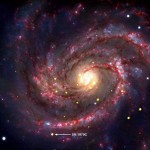That’s the teaser for a live televised press conference at NASA scheduled for just a few hours from now — at 12:30pm EST. Something has been discovered by the Chandra X-ray Observatory. Science researchers who will be on hand to answer questions include:
- Jon Morse, director, Astrophysics Division, NASA Headquarters in Washington
- Kimberly Weaver, astrophysicist, NASA’s Goddard Space Flight Center, Greenbelt, Md.
- Alex Filippenko, astrophysicist, University of California, Berkeley
Gateway to the Universe – Chandra Observatory website, run by Smithsonian Astrophysics, and hosted by Harvard.edu.
Watch the press conference online here: NASA TV.
UPDATE: NASA has announced the likely existence of a newly formed black hole in our “cosmic neighborhood.” Does that mean the Earth is about to be swallowed up by a gravity-crushing singularity? Uh, no.
Turns out NASA defines our neighborhood rather broadly, as this new black hole is approximately 50 million lightyears away. That’s so far away, that it has taken light 50 million years to reach us. What’s notable is that this black hole was born in the aftermath of a relatively small star that was observed to go supernova (gigantic explosion) just 30 years ago. The remainder of the star (so the theory goes) has collapsed into a gravity well so strong that not even light photons can escape if they pass too near — hence the name “black” hole.
Astronomers have observed the formation of black holes from supernovas elsewhere in the universe. But those others were billions of lightyears away, and born out of super-massive stars. Being able to study the ongoing evolution of a “nearby” black hole that’s of a more typical stellar size will give astronomers plenty of useful data to work with for years to come.
More about this significant astronomical finding from Wired Science.
Tags: astronomy, Light, lightspeed, mystery, photons, Physics, space, Universe



